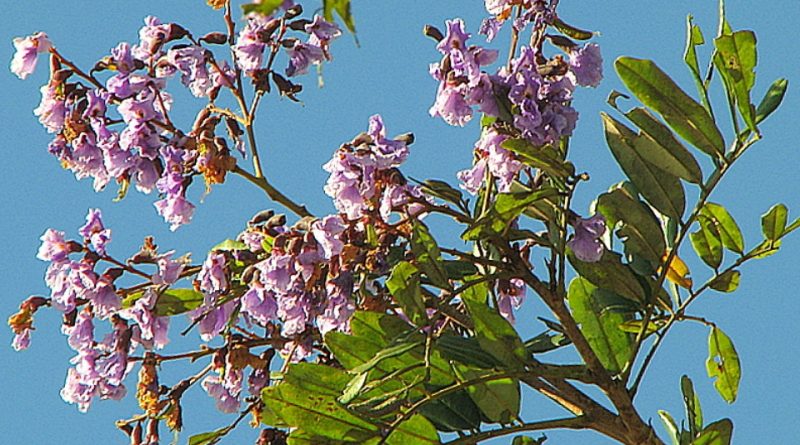Bowdichia virgilioides
Bowdichia virgilioides
Alcornoque (Bowdichia virgilioides Kunth) is an arboreal species belonging to the Fabaceae family.
Systematic –
From a systematic point of view, it belongs to the Eukaryota Domain, Plantae Kingdom, Magnoliophyta Division, Magnoliopsida Class, Fabales Order, Fabaceae Family, Faboideae Subfamily, Leptolobieae Tribe and therefore to the Genus Bowdichia and to the Species B. virgilioides.
The term is synonymous:
– Cebipira virgiliodes (Kunth) Kuntze.
Etymology –
The term Bowdichia of the genus was dedicated to the botanist, collector of plants from West Africa, T. E. Bpowdich (1791-1824).
The specific epithet virgilioides is derived from the similarity to Virgilia, an African tree.
Geographical Distribution and Habitat –
Bowdichia virgilioides is a plant native to southern and central America where it grows in habitats with the presence of rain forests and savannas where it grows better than areas with well-drained soils.
Description –
Bowdichia virgilioides is a fairly fast growing evergreen tree, which grows up to 36 m in forest ree, while in the savannah it is much smaller and can only grow up to 16 m.
it has ovate lanceolate, imparipinnate leaves.
The flowers, which are pollinated by insects, of the typical shape of the papilionaceae, are light blue-violet in color and are carried in groups at the top of the twigs.
The fruits are pods.
Cultivation –
Alcornoque is a plant that can be used as a pioneer species in the woods.
It is a plant suitable for not very heavy and in any case well-drained soils and can tolerate drought but grows hard in the shade.
For optimal growth you need to choose a sunny position. It is a fairly fast growing tree, capable of reaching a height of about 3 meters within 2 years of sowing.
This species has a symbiotic relationship with some soil bacteria, these bacteria present in the root nodules fix atmospheric nitrogen. Part of this nitrogen is used by the growing plant, but a part can also be used by other plants that grow nearby.
Before sowing, the seed which is somewhat hard must first be scarified to speed up germination. This can usually be done by pouring a small amount of almost boiling water over the seeds (being careful not to cook them) and then immersing them for 12-24 hours in hot water.
Sowing should be done in a sunny position in a nursery or in individual containers. From the untreated seeds there is normally a very low germination rate with the formation of sprouts within 30 – 60 days.
When the seeded seedlings reach 5-6 cm, they can be planted in individual containers and must be ready to be transplanted 5 – 6 months later.
Uses and Traditions –
The Bowdichia virgilioides, as well as for forestry or ornamental uses, is used for multiple uses.
The root tubercles and the bark are antirheumatic, astringent, purifying, febrifuge and hypoglycemic. They find application, for external use, in the treatment of skin diseases.
The seed oil is rubbed onto the skin to treat joint pain. Alkaloids are extracted from the bark.
The heartwood, varying in color from brown to reddish-brown; it is clearly delimited by the narrow band of an almost white sapwood.
The wood is hard, strong, rigid, fairly heavy, very robust and very resistant to attack by insects. It is not easy to work with hand tools, especially if there is a cross grain; can be planed on a good surface if a low cutting angle is used; quite difficult to nail, but the nailing and screwing characteristics are good; ends uniformly and take a high polish.
It is a very decorative and carpentry wood, where it is used for finishing interiors such as floor boards, frames, panels and doors, as well as for hubs, wheel axles.
Method of Preparation –
In addition to forestry, ornamental or for the use of timber, this plant is used in the pharmaceutical field where root tubercles and bark are used.
In addition, seed oil is used on the skin to soothe joint pain.
Guido Bissanti
Sources
– Acta Plantarum – Flora of the Italian Regions.
– Wikipedia, the free encyclopedia.
– Treben M., 2000. Health from the Lord’s Pharmacy, Tips and experiences with medicinal herbs, Ennsthaler Editore
– Pignatti S., 1982. Flora of Italy, Edagricole, Bologna.
– Conti F., Abbate G., Alessandrini A., Blasi C. (edited by), 2005. An annotated checklist of the Italian vascular flora, Palombi Editore.
Warning: Pharmaceutical applications and alimurgical uses are indicated for information purposes only, they do not in any way represent a medical prescription; therefore, no responsibility is accepted for their use for healing, aesthetic or food purposes.


